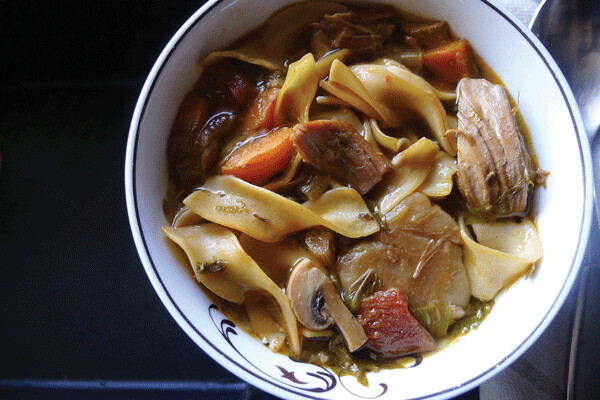Leftover Turkey Noodle Soup

Thanksgiving marks the start of the holidays, and a parallel season of enhanced leftovers consumption. It can be a freewheeling, chaotic time, when pieces of feasts and roast beasts are combined and reheated. But amid improvisations like refried mashed potatoes and microwaved kale salad, the most sacred act of leftovers season remains constant: bird bone soup.
The process begins when the table is cleared. As the uneaten sides and desserts are wrapped for the fridge, the motivated host will cut the remaining meat off the carcass, pluck leftover turkey bones from the returned plates, and add the bones and sinew to the stock pot. If you get started like this before the dust settles, that's one less large object to cram into the fridge.
The first step in cooking a bird bone soup is to prepare a stock from the carcass, herbs and aromatic vegetables. What you do with that stock is up to you. I recommend turkey noodle soup.
For me, bone broth soup isn't just a holiday ritual. It's a literal way of life. Whether it's from a deer, cow, pig, fish or a rotisserie chicken in a plastic bag from the supermarket, I'm loath to throw away a bone without simmering it first to extract its goodness.
If you have a pasta pot with a removable insert drainer, I recommend using it. That way you can keep simmering your bones in the soup for as long as possible, even after you've added veggies and meat and other ingredients that will be in the finished soup. If you don't have a pasta pot, use a colander to strain the finished stock before making soup.
When I make bone stock, I try to cut, break, smash and otherwise reduce the size of the bone pieces as much as possible. This facilitates the release of marrow and other beneficial bone particles.
But going to such lengths, admittedly, is not absolutely necessary. If you aren't up to bone breaking, don't sweat it. And definitely don't hurt yourself. There is, in fact, a decent argument against breaking the bones: leaving them intact creates a more clear and delicate stock.
But we are making leftover turkey noodle soup, which like leftover season itself is a raucous affair. It may be clouded by dissolved roast potatoes. There may be little bits of stuffing. Everything suspended in a glorious semi-solid matrix of bird-broth-bloated egg noodles.
Turkey Bone Soup, with noodles
If you can make this recipe without a single trip to the store, do, even if it means skipping the parsnips, mushrooms or hoisin sauce. If you don't have wine, use a little vinegar for the acid. But, if you don't have onion, carrot and celery, then you are going shopping. Ditto for the noodles.
1 turkey (or other bird) carcass
6 sticks celery: 3 chopped finely (about 2 cups), 3 cut in half, plus the leaves
6 medium carrots: 3 chopped (about 2 cups), 3 cut in half
2 onions: 1 chopped finely (about 2 cups), 1 sliced in half
4 sprigs fresh thyme
4 sage leaves
1 (14 oz.) can diced tomatoes (or rough equivalent in other tomato form)
2 cups mushrooms, cut into quarters
1 parsnip, chopped
Leftover veggies and pan drippings if available
1 cup wine
½ cup soy sauce
Salt
Pepper
Egg noodles
1 tablespoon hoisin sauce
3 cloves garlic, minced
Fill a pasta pot or stock pot ¾ full of water, and place on high heat.
Pull apart the carcass, bones and everything in between, yanking off the bits of cartilage and connective tissue while stripping the good pieces of meat. Keep the meat in the fridge.
Cut the bones and connective tissues into as many small pieces as you can with a pair of kitchen scissors, including the soft ends of the long bones. Smash what you can't cut, if you are up to it, but don't hurt yourself.
Broken or not, add the bones, along with all of the cartilage, skin, onion halves, large sections of celery and carrot, thyme and sage to the pasta insert or stock pot. Simmer for as long as time permits, up to 10 hours.
When it's time to make the soup, remove the bones - if using a pasta pot, do so slowly so they drain into the pot, and set the insert in a container to catch further drainage. If not using a pasta cooker, strain the bones in a colander.
Add the chopped celery, carrot, onion, tomato, mushrooms, parsnip, wine, soy sauce, pan drippings, leftover veggies and meat, cut into bite-sized pieces, to the pot, on medium heat. If using a pasta boiler, and if space permits, put the bones back in the soup while it cooks. Sip the broth every half hour or so to check the seasoning, and adjust the salt and pepper and wine as necessary.
About 30 minutes before serving time, add the celery leaves, hoisin sauce and garlic.
Now it's time for the noodles. You can either add them directly to the soup, or cook them separately and add them. Neither is a perfect solution, as cooking the noodles in the soup means leftovers will be soggy, while cooking the noodles in water deprives them of the opportunity to get bloated by bone broth.
If using a pasta boiler, you don't have to choose, because you can dump the bones and use the insert to cook the noodles in the soup, and then add them as needed to each bowl at serving time.
